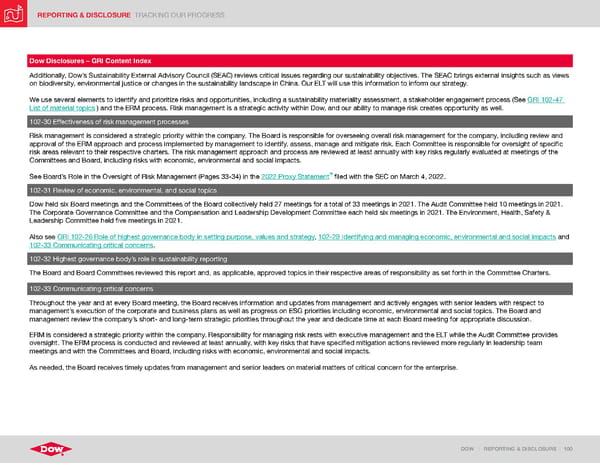REPORTING & DISCLOSURE TRACKING OUR PROGRESS DOW | REPORTING & DISCLOSURE | 100 Dow Disclosures – GRI Content Index Additionally, Dow’s Sustainability External Advisory Council (SEAC) reviews critical issues regarding our sustainability objectives. The SEAC brings external insights such as views on biodiversity, environmental justice or changes in the sustainability landscape in China. Our ELT will use this information to inform our strategy. We use several elements to identify and prioritize risks and opportunities, including a sustainability materiality assessment, a stakeholder engagement process (See GRI 102-47 List of material topics ) and the ERM process. Risk management is a strategic activity within Dow, and our ability to manage risk creates opportunity as well. 102-30 Effectiveness of risk management processes Risk management is considered a strategic priority within the company. The Board is responsible for overseeing overall risk management for the company, including review and approval of the ERM approach and process implemented by management to identify, assess, manage and mitigate risk. Each Committee is responsible for oversight of specific risk areas relevant to their respective charters. The risk management approach and process are reviewed at least annually with key risks regularly evaluated at meetings of the Committees and Board, including risks with economic, environmental and social impacts. See Board’s Role in the Oversight of Risk Management (Pages 33-34) in the 2022 Proxy Statement filed with the SEC on March 4, 2022. 102-31 Review of economic, environmental, and social topics Dow held six Board meetings and the Committees of the Board collectively held 27 meetings for a total of 33 meetings in 2021. The Audit Committee held 10 meetings in 2021. The Corporate Governance Committee and the Compensation and Leadership Development Committee each held six meetings in 2021. The Environment, Health, Safety & Leadership Committee held five meetings in 2021. Also see GRI 102-26 Role of highest governance body in setting purpose, values and strategy , 102-29 Identifying and managing economic, environmental and social impacts and 102-33 Communicating critical concerns . 102-32 Highest governance body’s role in sustainability reporting The Board and Board Committees reviewed this report and, as applicable, approved topics in their respective areas of responsibility as set forth in the Committee Charters. 102-33 Communicating critical concerns Throughout the year and at every Board meeting, the Board receives information and updates from management and actively engages with senior leaders with respect to management’s execution of the corporate and business plans as well as progress on ESG priorities including economic, environmental and social topics. The Board and management review the company’s short- and long-term strategic priorities throughout the year and dedicate time at each Board meeting for appropriate discussion. ERM is considered a strategic priority within the company. Responsibility for managing risk rests with executive management and the ELT while the Audit Committee provides oversight. The ERM process is conducted and reviewed at least annually, with key risks that have specified mitigation actions reviewed more regularly in leadership team meetings and with the Committees and Board, including risks with economic, environmental and social impacts. As needed, the Board receives timely updates from management and senior leaders on material matters of critical concern for the enterprise.
 ESG Report | Dow Page 99 Page 101
ESG Report | Dow Page 99 Page 101